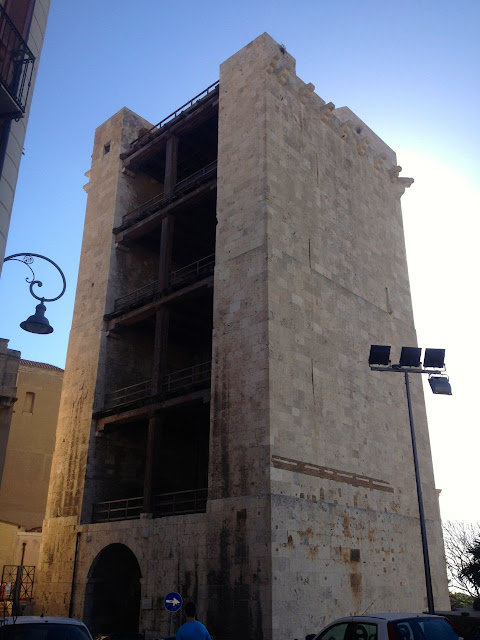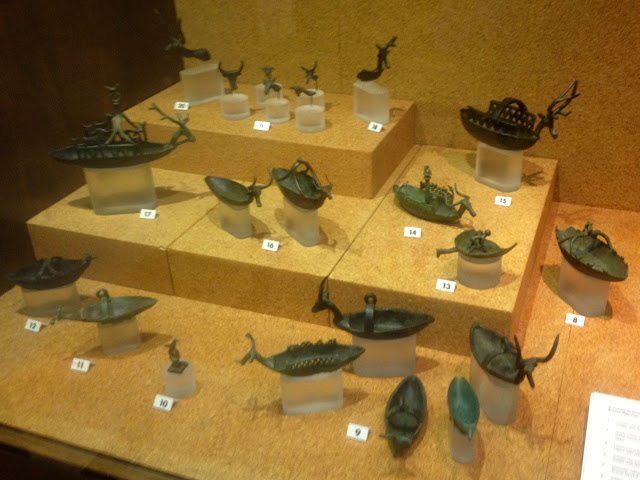An Outlying Italian Island
In a word Cagliari was just okay. Located on the island of Sardinia, about half
way between mainland Italy and Spain, it is probably my least favorite city in
Italy. While we didn’t have any major set
backs like in Malta two days prior, the city’s few attractions and bad neighborhoods
limited our attention to a few hours.
The only thing I did to prepare for our time in Cagliari was
download an app with a map of the city, on which I was also able to load points
of interest (museums, archeological site, etc.). While the app wasn’t as good as the Rhodes
app, it wasn’t as bad as the Valletta app either. Not knowing anything about the history of the
island I wanted to learn more, and used the app to find our way to the Archeological
Museum.
Looking at the map of streets the museum did not look very
far, crowded in the Citadel of Museums with other art museums. However, the map did not make plain the uphill
hike we would have to endure through graffiti infested neighborhoods to get
there. At times it seemed there was more
spray paint than actual paint on the buildings and fences. While some of the graffiti showed promise of
a talented artist, much of it was in poor taste and poorly done. I would have moved quickly through this area
if it was not for the severe uphill grade to the museums.
Our end destination the Citadel of Museums is just that, a citadel
in which five or so museums are collected.
Medieval Cagliari adopted much of the same anti-pirate architecture as
Malta. The medieval city was set high up
on a steep hill and completely encircled in a multi-story high wall. Within the medieval section, another set of
walls at the highest point lays the Citadel of Museums.
The old city is now completely devoured within the sprawling
new city, and the only indication we were making the transition was by walking
through a tunnel barely wide enough for a car to fit, and through which cars do
drive. I said a silent prayer a car
would run into me as I edged along the wall of the tunnel into the city.
 |
| These large statues of ancient Sardinia are mysterious, as the largest of ancient artwork no one knows why they were constructed. |
The Archeological Museum was only five euro a person, and
provided enough history to satisfy me.
It is currently undergoing a revitalization of its exhibit to make them
multilingual, and currently only about half of the plaques sport English. It was enough to get the general idea.
The island has been inhabited for tens of thousands of years,
with bronze age dwellers particularly of carving large human-like statues built
to guard their necropolises (large crypts in which the dead were interred) as
small bronze figurines made of molds. The
first trade of the volcanic island was obsidian mining, much desired in the
time before metal forging for its use in knives and arrowheads. Obsidian was traded off the island to
mainland Europe and Africa before written language even made it to the
island. Small groups which could be
called tribes or city states emerged with time, and all fell when the Roman
empire conquered the island. Eventually
Sardinia became part of Italy, the country it belongs to today.
 |
| Underneath the altar of this church in old Cagliari are a collection of crypts, exquisitely decorated. |
After our venture through the museum we meandered back downhill
towards the cruise port, stopping on the way at a church with a fantastic
underground crypt under its altar housing important church leaders. After the church, we set our sights on
climbing one of the defensive towers built in the thirteen hundreds.
 |
| Off of the main crypt underneath the altar are two smaller rooms holding what I can only describe as Catholic Sarcophaguses. |
Called the Elephant tower, this tower along with a few
others, stand several stories tall over fearsome metal gates to the city. Not for the weak of heart, the steep stairs will
prove a challenge for many. Plenty fit
to have no problems climbing up, I took pause with my fear of heights on the
descent. The steps were so narrow my
foot would only fit sideways. I thoroughly
enjoyed the tower, but was quick to descend when David reminded me how old it
was.
 |
| This elephant tower is one of many towers positioned strategically on the walls of Old Cagliari. A gate runs through its base. |
We exited the old city via the gate beneath the Elephant
tower. This saw us enter the major
thoroughfare of modern Cagliari. However,
there was as much an abundance of black-market merchants peddling handbags,
purses, and jackets as anything else.
Their constant presence on the sidewalk crowded the walkways and ruined
the ambiance. Not finding anything but
crowded streets we headed back to the ship.
I wouldn’t go out of my way to visit Cagliari again. If I was on a cruise ship docked in port I am
not sure I would even get off. The rest
of the island has more to offer with UNESCO world heritage sites, but it would
take a good deal and some convincing to get me to commit to an excursion. All of the excursion options we had for the
rest of the island were too expensive for my taste. I’d rather go back to mainland Italy, where I
never got bored.
 |
| The cruise ship in port as seen from the Elephant Tower. |






No comments:
Post a Comment